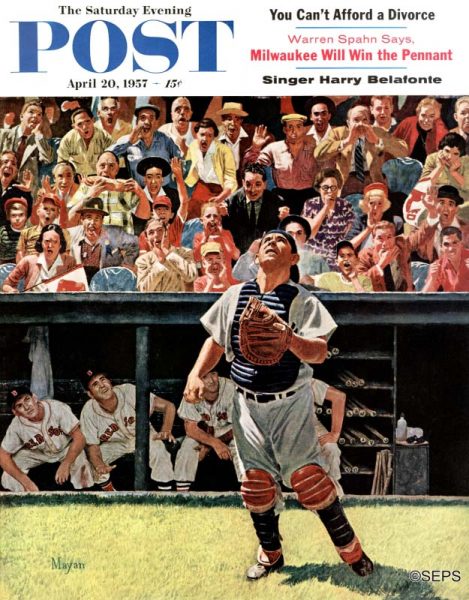2. Escalating Salaries/Changing Realities
After completing this or multiple sections of this lesson plan, please take 5 minutes to complete the survey at the bottom of this page. Your feedback will be extremely valuable for future curriculum updates and additions.
Part 2A:
In 1957 Yogi Berra was Major League Baseball’s highest paid star. His contract is below. Share the document with your students and ask the class what strikes them about its contents.
To the teacher: Students will likely note that the 1957’s highest paid player was receiving ONLY $65,000/year!

Yogi Berra’s Uniform Player’s Contract
Explain to students that because of dramatic increases in player salaries, many commentators have redirected the conversation about player finances to the salaries themselves: should professional athletes be making the amount of money they currently make? “As salaries grow larger,” it has been argued, “so too do the problems associated–as salaries get bigger, problems get bigger.” In 1957 the highest paid player in Major League Baseball was Yogi Berra, with an income of $65,000, compared to the highest paid player in 2016, Clayton Kershaw, with an income of $33 million. How do the students feel about the difference between the two players’ salaries?

1957 edition of The Saturday Evening Post featuring Yogi Berra on the cover

LA Dodgers star pitcher, Clayton Kershaw
Do the math!
- The highest salary in 1957 was Yogi Berra’s at $65,000.
- The highest salary in 2016 was Clayton Kershaw’s at $33,000,000.
- The average American salary in 1957 was $3,860.
- The average American salary in 2016 was $31,099.
Calculate how many times higher 1957’s highest baseball salary was relative to 1957’s average American salary.
Compare that with how many times higher 2016’s highest baseball salary was relative to 2016’s average American salary.
Create a rudimentary graph of the results, illustrating the inflation in top baseball salaries relative to average American salaries in the years 1957 and 2016. Put the years on the X-axis and the salaries on the Y-axis, plotting both average American salary and highest salary in baseball for the designated years.
To the teacher: The highest baseball salary in 1957 was 16.8 times higher than the average American salary, while the highest baseball salary in 2016 was 1,061.1 times higher than the average American salary of 2016! The graph will illustrate this dramatic rise.
Questions for Students:
- How would you describe the contrast between the increase in average American salaries between 1957 and 2016 and the increase in top baseball salaries in that same period?
- What do you think about the inflation of player salaries? Is it justified? Why or why not?
- What problems might result from escalating inflation in player salaries?
- For the player receiving $33,000,000, do you imagine that he is “set for life”?
- Do you support the increase in player salaries? Why?
- Do you think it might be difficult for a young player to adjust to the large salary of professional sports? Why?
Share with students this additional way to consider the inflated professional baseball player salary:
- 1975 average MLB salary: $45,000, which is three times the average American salary
- 2010 average MLB salary: $2,400,000, which is fifty times the average American salary
- 2018 average MLB salary: $4,100,000, which is eighty times the average American salary
Give students copies of Handout #3. Form two groups, one for and one against salary inflation, in order to conduct a structured debate regarding the pros and cons of increased player salaries. Appoint two team leaders for each debate group. Have the team leaders guide their groups through a reading of the Handout, compiling whatever information will help them support their debate position. No matter the side of the argument a team is defending, have them consider their opposition’s handout materials in order to better secure their own argument.
Part 2B:
Change Up! The Game of Baseball & Financial Literacy
For this board game activity, print out the necessary materials that are included below. Materials include the game board (in four pieces), activity cards and ledger sheets. Additionally, each group will need a pair of dice and small game tokens to represent each player (sized to fit in the board spaces). Ideally, you should have one board for every four students. If necessary, two students can share a single player position, allowing eight students per board. Print out the instructions below to go over with the class, reviewing these prior to class time, but also point out to each group that the instructions also live on each game board for them to consult as they play. In general, students will need at least one full 45-minute class period to play the game.

Board Game Materials To Print*
Game Board
(must print all four pieces and assemble to create one complete game board):
Piece 1 (Upper Left) | Piece 2 (Upper Right)
Piece 3 (Lower Left) | Piece 4 (Lower Right)
Ledger Sheets | Activity Cards
*All materials should be printed on 8-1/2” x 11”-sized paper
Game Rules and Instructions:
Object: The object of the game is to become the first player with a net worth of $50,000,000 or more.
Equipment: The equipment consists of a game board (split in four pieces, to be printed separately and assembled) and activity cards (to be printed and cut). You will also need to provide 2 dice and 4 small game tokens.
Ledger Sheet: Each player will be provided with a ledger sheet to keep track of their income and expenses throughout the game.
Preparation: Print game board on four pieces of 8-1/2” x 11” paper. Tape pieces together to form game board. Stack activity cards on designated spots in the middle of game board. Players select game tokens, placing them on Minor Leagues space to begin. Players receive base salary of $500,000 dollars to start the game, already noted on their ledger sheets.
The Play: After you have determined your playing order, each player will take a turn rolling the dice. Each player’s first roll will determine their signing bonus. (As represented by the “Signing Bonus Chart” at the side of the game board.) After that, players take turns rolling dice to determine how many spaces they should advance their token on the game board. One trip around the board represents one season in the career of each player. Every time players pass “Minor Leagues,” they are entitled to collect their salary as well as any additional money earned through endorsements. There are several different types of activity spaces that each player may land on throughout the game:
Play Ball!: Upon landing on “Play Ball!,” players draw the top card from the designated pile in the middle of the board. “Play Ball!” cards describe consequences related to player performance on the field — both positive and negative.
Family Matters: Upon landing on “Family Matters,” players draw the top card from the designated pile in the middle of the board. “Family Matters” cards relate to players’ financial decisions with regard to family and friends.
Spending Spree: Upon landing on “Spending Spree,” players draw the top card from the designated pile in the middle of the board. “Spending Spree” cards relate to players’ personal financial decisions with regard to lifestyle choices, such as the purchase of luxury items.
Property: Multiple properties are available for purchase on the board. If players land on an unowned property, they may purchase that property for the price indicated. If players land on a property owned by another player, they must pay the owner 50% of the property’s purchase price in rent.
Agents: Five agents for hire are available to players. Upon landing on an agent space, players have the option to hire the agent for the price indicated. Each agent has a unique salary multiplier as listed on the space. Upon hiring an agent, players determine their new annual salary by multiplying their salary by their agent’s multiplier.
Endorsements: If players land on an endorsement space, they are entitled to collect the value of that endorsement in addition to their annual salary every time they pass “Minor Leagues” on the board. Multiple players may enjoy the same endorsements simultaneously.
Taxes: If players land on a tax space, they must pay the percentage of their income as indicated.
Injury: If players land on an injury space, they must forfeit the number of turns indicated.
Minor Leagues: If players land on “Sent to the Minors!,” they must move their token directly to the “Minor Leagues” space and forfeit collection of their salary and endorsements for the year. Players must roll doubles to get out of the Minors Leagues. If doubles are rolled, players may advance their token the number of spaces on the dice. After two failed attempts to roll doubles, players roll and advance on their next turn.
Signing Bonus/Salary Rolls: A chart of Signing Bonus/Salary values that correspond to each roll is included in the lower right corner of each game board.
Conclusion: Most of us will never be professional athletes or lottery winners. But can these exceptional cases teach all of us something about managing finances? No matter one’s income, financial planning is an important part of adult life. As a class, create a set of tips, based on what’s been learned in this lesson, for managing finances in everyday life.
Reflection Question for Key Terms:
Write a short paragraph offering advice to rookie players entering the Major Leagues, making use of all the Key Terms from the pre-lesson activity.
Extension Activities:
- Read the following articles from The Undefeated about financial planning for professional athletes and retirement transitions from high income to lower income categories. After reading the pieces, find and research a player story that reveals the financial challenges of retirement from professional sports. Next, play the role of financial advisor to a young player. What would you do to assist an athlete just starting their professional career?
Why do so many pros go broke?
Pro athletes need financial advice before the first snap
- Read the article entitled “Why Female Athletes Earn Less Than Men Across Most Sports,” a Forbes magazine piece written by Olivia Abrahams. In a one-page response, highlight the problems the writer delineates and offer some speculative solutions to those same problems.
- Watch the documentary Broke, from the ESPN 30 for 30 series. After viewing, write a two-page review of the film, giving it a letter grade and backing your evaluation with evidence from the film. What were the film’s strengths? Its weaknesses? Write as if you’re advising potential viewers and giving them a sense of the film’s value.
Lesson Plan Home:
Financial Literacy & the World of Professional Sports
Section 1:
Jackpot! From Lotteries to Contracts
Post-Lesson Survey
Please complete this 5-minute, post-lesson survey. Your feedback will be extremely valuable for future curriculum updates and additions.

